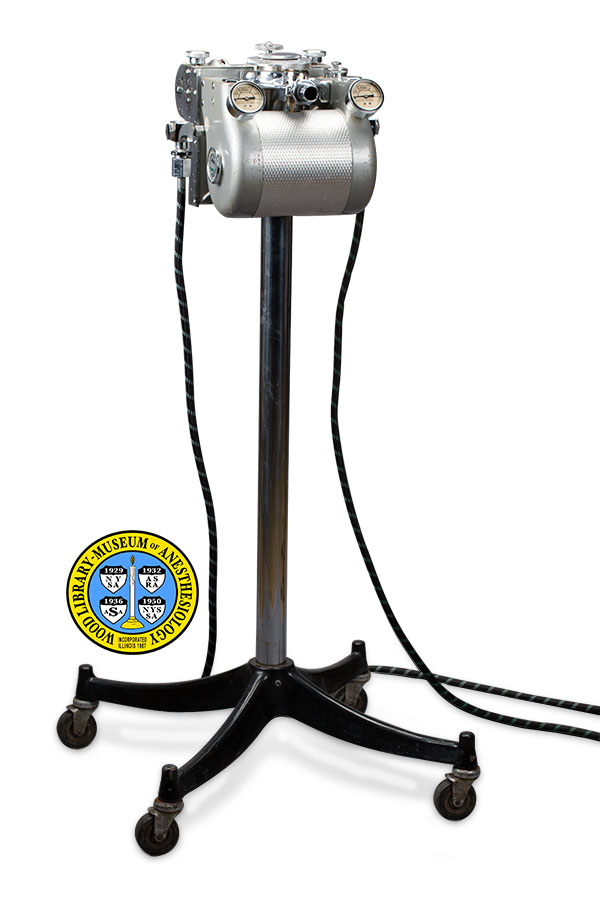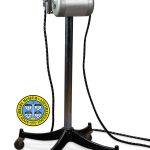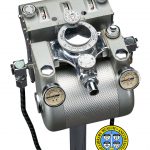McKesson Narmatic
The McKesson appliance Company was founded in Toledo, Ohio, by Elmer I. McKesson, M.D. (1881-1935). Although he was a proponent of patient safety, Dr. McKesson was also a firm believer in what he called secondary saturation. This technique delivered a high concentration of nitrous oxide gas during induction (the first stage of inhalation anesthesia). This was later found to deprive the body of adequate oxygen.
In the late 1950s, the McKesson Co. introduced the Narmatic machine. It was based on the McKesson Nargraf, the first anesthesia machine with a built-in recorder of patient vital signs. The smaller Narmatic could deliver only nitrous oxide and oxygen, and had no recording component. It was favored by dentists, who did not need additional gases and usually performed short procedures.
Both the Nargraf and the Narmatic were intermittent flow (also called demand flow) machines. They relied on the patient's spontaneous respiration for the delivery of gases. This method was criticized in the 1970s as being inferior to the delivery of gases through intermittent positive pressure, which more modern equipment could do. At that time McKesson's machines were still in wide use, but McKesson's preference for older technologies may have helped lead to the demise of the company.
Catalog Record: McKesson Narmatic McKesson Narmatic
Access Key: aqku
Accession No.: 2005-11-19-1
Title: McKesson Narmatic / Elmer I. McKesson.
Corporate Author: McKesson Appliance Company.
Title variation: Alt Title
Title: McKesson Model O.
Publisher: Toledo, Ohio : McKesson Appliance Co., [between 1958 and 1975?]
Physical Description: 1 anesthesia machine : metals, rubber ; 21 x 27 x 28 cm.
Subject: Anesthesia, Inhalation – instrumentation.
Subject: Anesthesia Machines.
Subject: Anesthesia, Dental – instrumentation.
Subject: Nitrous Oxide.
Subject: Oxygen.
Note Type: General
Notes: The first year in the date range is based on an advertisement that describes the Narmatic model as “new”. The second year in the date range is based on the latest published description found by the cataloger.
The object is described from the perspective of the user, with all control dials and gauges facing forward.
Married to the stand from accession # 2007-11-01-3 B, and to tanks from the parts collection, for purposes of photography.
Note Type: With
Notes: McKesson cloth-covered oxygen hose and nitrous oxide hose. The oxygen cord is 133 centimeters long. The nitrous oxide cord is 137 centimeters long. These parts were received together with this example of the Nargraf head.
Note Type: Citation
Notes: Allen GD. The enigma of air dilution. Anesthesia Progress. May-June, 1970;17(3):52-54.
Note Type: Citation
Notes: Allen GD. Dental Anesthesia and Analgesia. Baltimore: Williams & Wilkins Company, 1972:72-74.
Note Type: Citation
Notes: Dorsch JA, Dorsch SE. Understanding Anesthesia Equipment: Construction, Care and Complications. Baltimore: Williams & Wilkins, 1975:72-77.
Note Type: Citation
Notes: Everett G, Hornbein TF. Hidden hazards of the McKesson Narmatic anesthesia machine. J Am Dental Assn. September, 1970;81(3):695-697.
Note Type: Citation
Notes: Authors answer criticisms [Letters to the editor]. J Am. Dental Assn. February 1971;82(2):269.
Note Type: Citation
Notes: McKesson Company File. Archives. Located at: Wood Library-Museum of Anesthesiology, Schaumburg, Illinois.
Note Type: Physical Description
Notes: One anesthesia machine head; Consists of a horizontal, cylindrical portion in front (possibly the mixing chamber) and a “P” shaped bellows compartment in back, with various controls and two hose connectors;
The cylindrical portion is topped by an armature that holds the vaporizer connector and two control dials; The larger dial is marked, from left to right: “McKesson Narmatic [new line] McKESSON APPLIANCE CO., TOLEDO, OHIO, U.S.A. [new line] OXYGEN PERCENT [new line] MODEL O [new line] 100, 75, 50, 25, 0, USE SMALL DIAL”; Mounted in front of this dial, and on top of the vaporizer connector, is a smaller dial marked: from left to right: “MM PRESSURE [new line] 0, 5, 10, 15, 20, 25, 30, 35, OFF”;
In front, the left-hand side frame of the cylinder holds a gauge marked, from left to right: “LOW [new line] OPERATING RANGE [new line] HIGH [new line] McKESSON APPLIANCE CO. [new line] TOLEDO, OHIO, U.S.A.”; A round plate on the left side frame of the cylindrical compartment is marked with the McKesson logo, and a decal that reads “N2O”; Extending from the left side frame is a hose connector marked “N2O”; Also in front, the right-hand side frame holds a gauge that is identical to that on the left; A round plate on the right side frame is marked with the McKesson logo and a decal that reads “O2”; Extending from the right side frame is a hose connector that is marked “O2”;
Behind the cylindrical portion is the bellows compartment, with three indicator dials and three gauges mounted on top; Turning each dial causes the indicator on the related gauge to move; The dial on the left is marked: “BREATHER VOLUME”; This dial operated the volume lever on the back of the compartment; The Breather Volume indicator is marked, from top to bottom: “400, 300, 200, 100, 00, CC, 0”; To the right of this is a dial that is mounted higher than the others, and in front of the center indicator; This middle dial is marked, from left to right: “OXYGEN PERCENT [new line] 0, 5, 10, 15, 20, 25, 30, 35, 40, 45”; The dial on the right is marked: “BREATHER PRESSURE”, and the related indicator is marked, from top to bottom: “15, 10, MN, 5, HG, 0”;
On the back of the bellows compartment, a metal flap covers a black rubber accordion bellows; When the bellows inflates, the flap is pushed upward; A lever in the center of the back opens this flap to a preset maximum of approximately 7 centimeters; The volume lever is mounted on the right side of the compartment.
Note Type: Reproduction
Notes: Photographed by Mr. Steve Donisch, June 20, 2017.
Note Type: Historical
Notes: Around 1910, Elmer I. McKesson, M.D. (1881-1935) founded the Toledo Technical Appliance Co., to manufacture anesthesia equipment of his own design. In 1930, the company name was changed to the McKesson Appliance Co. The year 1930 also saw the introduction of McKesson’s new Recording Nargraf machine. By 1962 the company had become a division of American Cryogenics, Inc. By 1975, McKesson had become a division of Narco Medical Co.
The Nargraf machine was produced in several models, and was the basis for some of McKesson’s smaller machines. One of these more portable units was the Narmatic, also called the Model O. It was advertised as a new machine in 1958. The Narmatic was still being marketed as late as 1969, and appeared in textbooks published in 1972 and 1975.
Both the Nargraf and the Narmatic were intermittent flow (also called demand flow) machines. They relied on the patient’s spontaneous respiration for the delivery of gases. This method was criticized in the 1970s as being inferior to the delivery of gases through intermittent positive pressure, which more modern equipment could do. At that time McKesson’s machines were still in wide use, but McKesson’s preference for older technologies may have helped lead to the demise of the company.
In the 1960s, disenchantment with intravenous analgesics led to a growing use among dentists of inhalation agents for analgesia (pain relief). But various studies raised concerns about the accuracy of some gas analgesia machines. In 1970, the Journal of the American Dental Association (JADA) published an article by Everett, Hornbein and Allen that harshly criticized the Narmatic. This article elicited several letters to the editor of JADA. The authors noted that the machine was “probably the most common equipment used for outpatient anesthesia in the United States today”. his 1972 textbook, Allen described the flaws of such machines, and stated that claims for their performance were unsupported. These statements were echoed by Dorsch & Dorsch in 1975, the latest publication in which the cataloger found the Narmatic discussed.
Note Type: Publication
Notes: Allen GD, Gehrig JD, Tolas AG. Evaluation of demand-flow anesthetic machines in dental practice. JADA. 1969;78:91.
Note Type: Exhibition
Notes: Selected for the WLM website.



